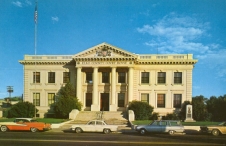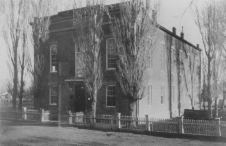Washoe County Courthouse
Established in 1861, Washoe County's original seat of government was in Washoe City, the location of its first courthouse. In 1871, the county government transferred to Reno where the commissioners built a simple brick Italianate courthouse. Shortly after the move, a contractor demolished the Washoe City courthouse for the brick.
By the turn of the century, Reno had grown into Nevada's largest city, and its courthouse no longer suited the emerging giant. When Washoe County called for designs for a new structure, the competition launched the remarkable career of Frederick DeLongchamps. The twenty-seven-year-old architect won the contest with a neoclassical facade that incorporated the walls of the 1872 courthouse.
The new Washoe County Courthouse was completed in 1911 at a cost of $250,000. It was DeLongchamps's most elaborate neoclassical design. Corinthian columns support a massive portico capped by a detailed cornice. A substantial copper dome sheltered an ornate leaded, colored glass ceiling. Elaborate details dominate both the exterior and interior.
Nevada's progressively liberal divorce laws attracted many people, including celebrities, to Reno to shed their marital bonds. The Washoe County Courthouse gained notoriety because of the many divorces concluded within its walls during the first few decades of the twentieth century. In the 1940s, DeLongchamps designed additions to either side of his award-winning courthouse. The new wings replicated the design of the original.
In the 1950s, the Washoe County commission approached DeLongchamps to design a larger structure. The architect presented one option that called for the demolition of the 1911 courthouse. Fortunately, the commissioners chose preservation and funded an addition to the rear. The 1963 International-style structure loomed over its precursor, but DeLongchamps's courthouse was saved. It remains an elegant expression of government, recalling an older Reno before it transformed into a gambling Mecca.



